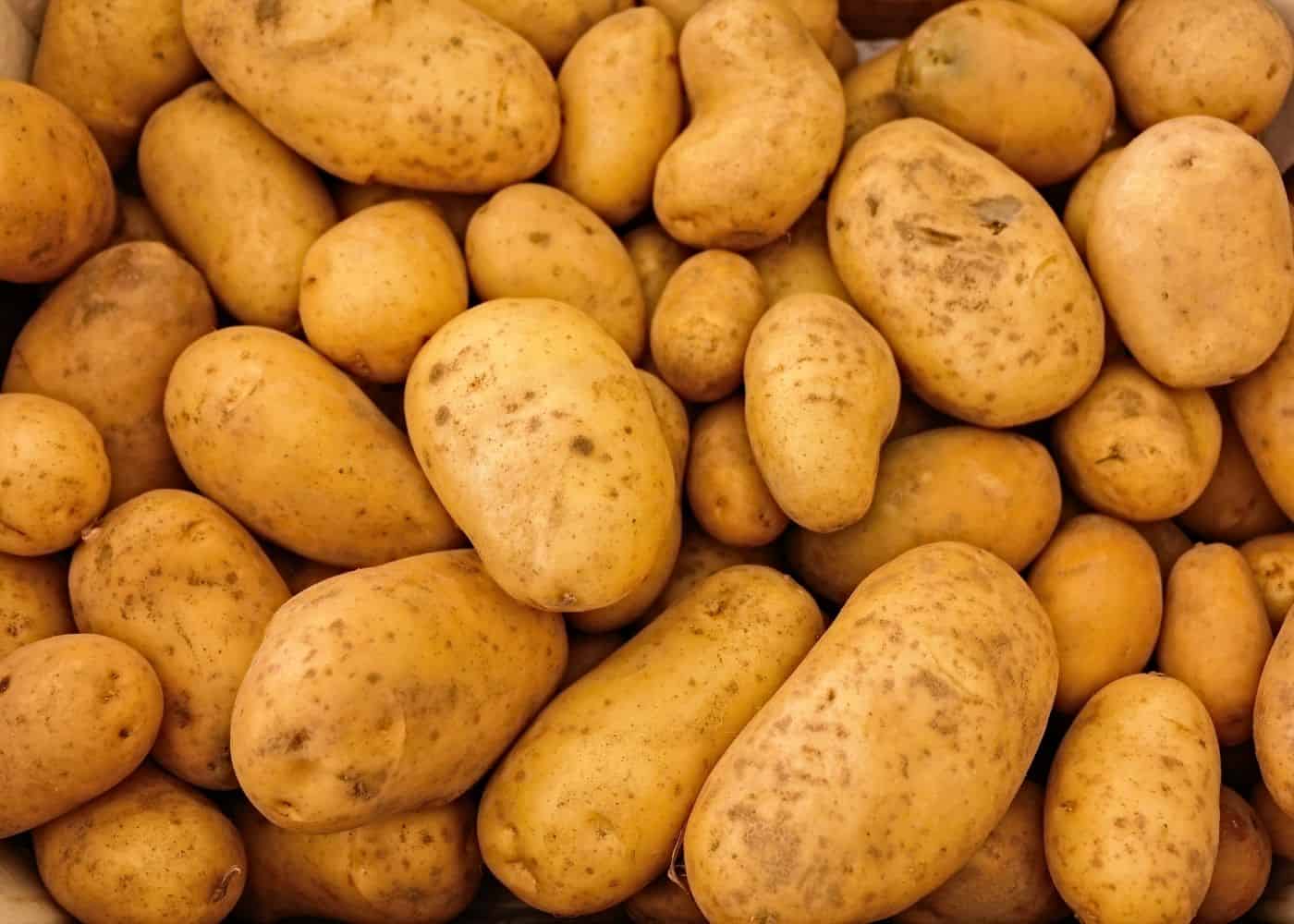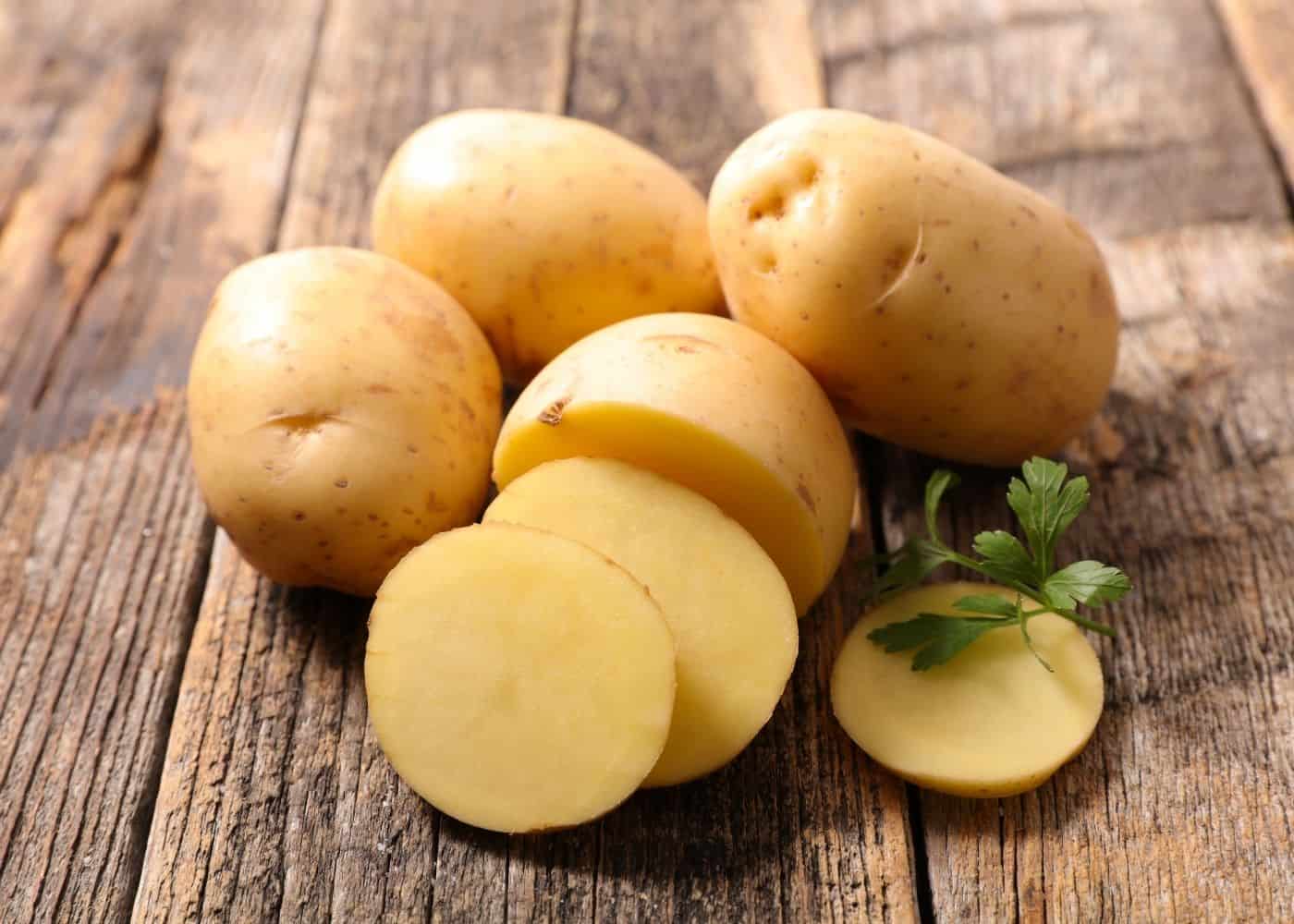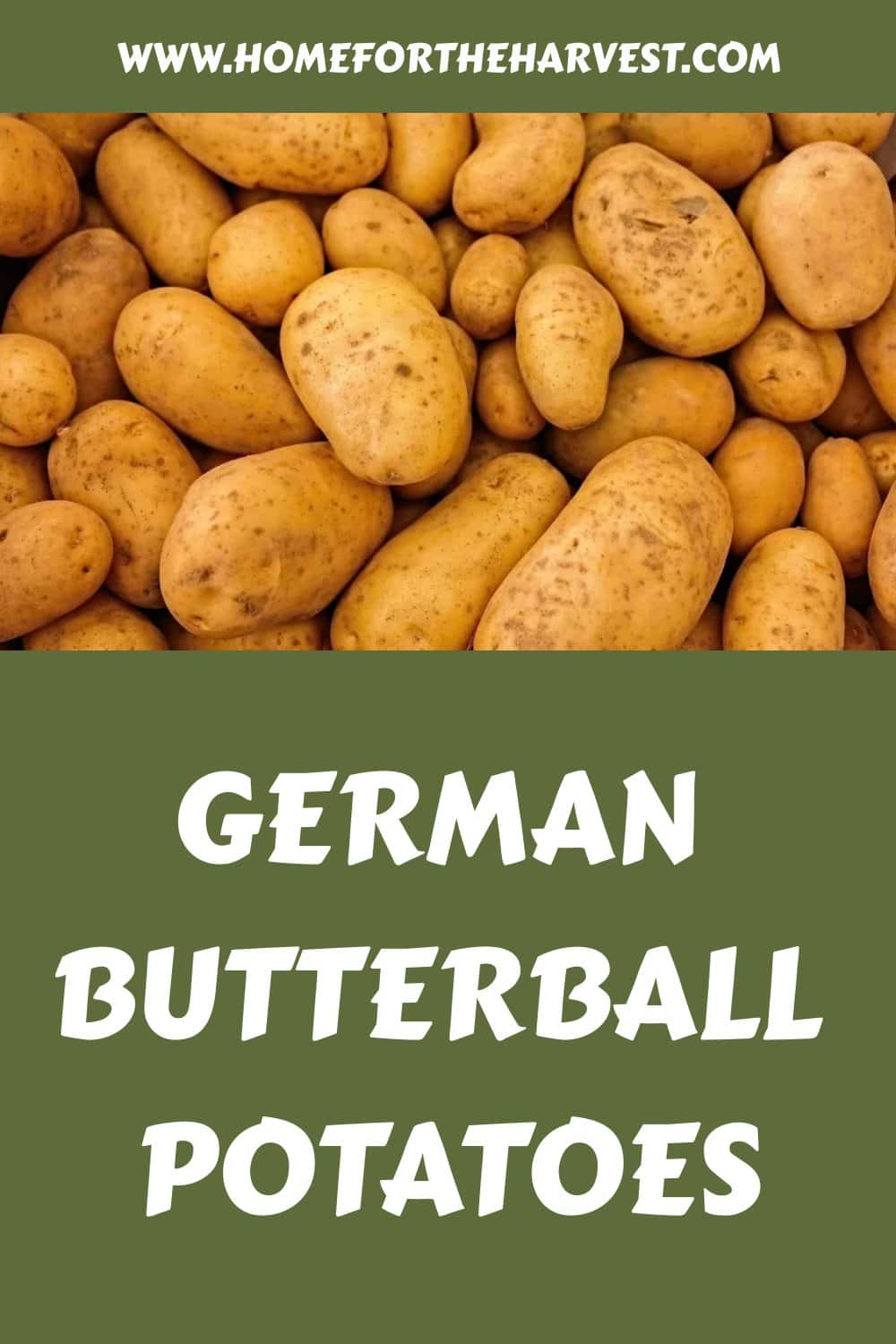Looking for a potato with a naturally buttery taste? Time to try the German Butterball potato!
German Butterball potatoes are a gourmet potato variety with a brown peel and yellow flesh. These specialty potatoes have a buttery melt-in-your-mouth flavor and flakey texture. German Butterball potatoes are most commonly used as baking potatoes but can also be fried or roasted. This is a late-season variety that generally takes 110-135 days to grow to mature size in the garden.
Read on to learn all about German Butterball potatoes!
Introduction to the German Butterball potatoes
The German Butterball potato is one of the most popular potato varieties for baked potatoes. These potatoes are also wonderful roasted, either on their own or alongside a meaty roast. This heirloom variety is known for its dense waxy texture and buttery creamy taste.

Where to buy German Butterball seed potatoes
Purchase seed potatoes online or from specialty gardening centers. Some local farmer’s markets and nurseries may also carry this gourmet potato variety. When purchasing seed potatoes, be sure to look for healthy, disease-free tubers that are firm and free of blemishes.
When to plant your potatoes
Potatoes are usually planted 2-4 weeks before the expected last frost date. Here are some estimates of potato planting month by USDA hardiness zone:
- Zone 10+: January
- Zone 9: early February
- Zone 8: late February
- Zone 7: early March
- Zone 6: late March
- Zone 5: early April
- Zone 4: late April
- Zone 3: early May
- Zone 2-: late May
Preparing German Butterball seed potatoes for planting
When planting German Butterball potatoes, it is best to start with seed potatoes that have been cut into small pieces, each with 2-3 eyes or buds. If you have particularly small seed potatoes with only a couple eyes each, you may not need to cut them up prior to planting.
Use a clean knife to cut up large seed potatoes into a few pieces. Let the pieces dry so the cut surfaces heal over. This usually takes a couple of days.
Once the cut seed potato pieces have dried, place them in a cool dry location out of direct sunlight for a few weeks to sprout. This process is called “chitting” the potatoes. Plant the potatoes once the sprouts are an inch or two long.
How to plant German Butterball potatoes
German Butterball potatoes are generally planted outdoors 2-4 weeks before the expected date of the average last spring frost. In most climates, this means planting in March or April, but it may occur in February in the south (or even in May in the north). Don’t delay planting as these potatoes require quite a long growing season in comparison to other potato varieties.
German Butterball potato plants need full sun to produce the best yield, but they will still do well with partial sun. The plants require well-drained soil that is high in organic matter. Add compost or well-rotted manure to the planting area a few weeks before planting. You can also use a pre-fertilized potting mix inside a potato grow bag.
This potato variety is suitable for growing in all USDA planting zones. However, it is a late-season variety, so gardeners in colder climates may find that the growing season here is too short to get full maturity before the first frost of fall.
Dig 6″ deep holes for your seed potatoes. Place a piece of seed potato in each hole with the sprouts facing upwards. Replace 3-6 inches of dirt. To achieve optimal yield and quality, the plants should be spaced at least 12-18 inches apart.
How to grow German Butterball potato plants
Seed potatoes generally take a couple of weeks to sprout outdoors. Once the sprouts are about 4″-6″ above the soil, mound some soil around the stem to “hill” up the potatoes. Leave about 2″ of the stem/foliage exposed to the sunlight. Keep hilling up the plant as it grows by burying the bottom portion of the exposed stem.
Here is a complete guide to growing your own potatoes in your garden.
Watering requirements for German Butterball potatoes
German Butterball potatoes require regular watering to thrive and produce a good yield. In general, you should water your plants about once or twice per week, depending on the weather conditions and soil type.
The best time to water is in the morning, as this will help prevent the plants from experiencing fungal diseases. It is important to keep the soil moist, but not waterlogged. Allow the top few inches of soil to dry out between watering.
Fertilizing German Butterball potatoes
German Butterball potatoes will benefit from regular fertilization throughout the growing season. Start by enriching the soil with composted manure or another slow-release fertilizer about a week or two before planting.
Use a balanced fertilizer and apply it according to the instructions on the packaging. Fertilize again once the plants start to flower, and wait a few weeks after mounding up the soil around your potato plants before you apply more fertilizer.
Harvesting German Butterball potatoes
German Butterball potatoes are ready for harvest about 4 months after planting, with an average days-to-maturity range of 110-135 days in optimal conditions. To harvest these potatoes, gently dig around the plants with a spading fork or your hands. Be careful not to damage the tubers. Brush off excess dirt and set them in the sun for a couple of hours. Then brush off more dirt.
German Butterball potatoes are excellent long-term storage potatoes. Once you have harvested the tubers, they need to be cured before they can be stored. Curing helps to heal any cuts or scrapes on the potatoes.
Place the potatoes on a wire rack or in a cardboard box, and store them in a cool, dry location with plenty of airflow. Most potato storage locations are at about 45-50 degrees F, but potatoes can last up to 5 months if you can maintain temperatures around 35 degrees F.
Companion plants for German Butterball potatoes
Some good companion plants for German Butterball potatoes include carrots, peas, parsley, and lettuce. These plants can help improve the yield and quality of your potatoes. They also help to deter pests and diseases. Additionally, these plants can add valuable nutrients to the soil.
Read more about companion planting with potatoes here.
Pests affecting German Butterball potatoes
Some common pests that affect German Butterball potatoes include aphids, Colorado potato beetles, cutworms, and white grubs. These pests can cause serious damage to your plants and reduce the yield of your crop.
To control these pests, you can use a variety of methods, such as traps, natural predators, and chemical pesticides. For instance, you can use floating row covers to prevent insects from laying eggs on your plants or release beneficial insects like ladybugs to prey on harmful pests.
Additionally, you can try using organic pesticides like neem oil or pyrethrin to control unwanted insects and keep your potatoes healthy. With regular monitoring and a little effort, you can keep these pests under control and enjoy a bountiful harvest of German Butterball Potatoes.
Diseases affecting German Butterball potato plants
Several diseases can affect German Butterball Potatoes, including early blight, late blight, fusarium wilt, and Verticillium wilt. These diseases can cause serious damage to your crop and reduce the yield of your potatoes.
To prevent these diseases, you should start by planting certified disease-free seed potatoes. Additionally, you can use crop rotation to break up the life cycle of fungal pathogens in the soil. You may also want to try using organic fungicides such as copper sulfate or sulfur to prevent diseases from taking hold.

Recipes using German Butterball potatoes
German Butterball Potatoes are perfect for making baked potatoes and also for roasting, boiling, or frying. Here are some ideas for cooking with your potatoes.
Baked German Butterball potatoes
Preheat the oven to 350 degrees Fahrenheit. Scrub the potatoes and dry them with a towel. Prick each potato several times with a fork. Rub the potatoes with olive oil or vegetable oil. Place the potatoes on a baking sheet and bake for 45-60 minutes, or until they are tender when pierced with a fork. Serve with butter, sour cream, chives, bacon bits, grated cheddar cheese, or other gourmet toppings.
Roasted German Butterball potatoes
Preheat the oven to 400 degrees Fahrenheit. Scrub the potatoes and dry them with a towel. Cut the potatoes into bite-sized pieces. Toss the potatoes with olive oil or vegetable oil. Place the potatoes on a baking sheet and roast for 20-30 minutes, or until they are golden brown and tender when pierced with a fork. Serve with ketchup, mustard, mayonnaise, or other dipping sauces.
Fried German Butterball potatoes
Heat a few inches of vegetable oil or ghee in a deep heavy-bottomed pot until it reaches 350 degrees Fahrenheit. Cut the potatoes into thin, bite-sized slices. Soak the potatoes in cold water for 10 minutes to remove excess starch. Toss the potatoes with all-purpose flour or cornstarch. Carefully add the potatoes to the hot oil and fry for 3-5 minutes, or until they are golden brown and crispy. Drain the potatoes on a paper towel-lined plate and serve with salt and pepper.
Boiled German Butterball potatoes
Scrub the potatoes and cut them into bite-sized pieces. Place the potatoes in a pot and cover them with cold water. Bring the water to a boil and cook for 10-15 minutes, or until the potatoes are tender. Drain the potatoes and serve with butter, sour cream, or other toppings.
FAQs about the German Butterball potato
What do German Butterball potatoes taste like?
German Butterball Potatoes are a gourmet potato variety with a buttery melt-in-your-mouth flavor and flakey texture.
Are German Butterball potatoes early or late?
This is a late-season variety that generally takes 110-135 days to grow to mature size in the garden.
How big do German Butterball potatoes get?
German Butterball potatoes are medium-large sized potatoes. They usually grow to a minimum of 10-12 centimeters long.
How do you grow Butterball potatoes?
Once the seed potatoes are planted outdoors and the sprouts are about 4″-6″ above the soil, mound some soil around the stem to “hill” up the potatoes. Leave about 2″ of the stem/foliage exposed to the sunlight. Keep hilling up the plant as it grows by burying the bottom portion of the exposed stem.






